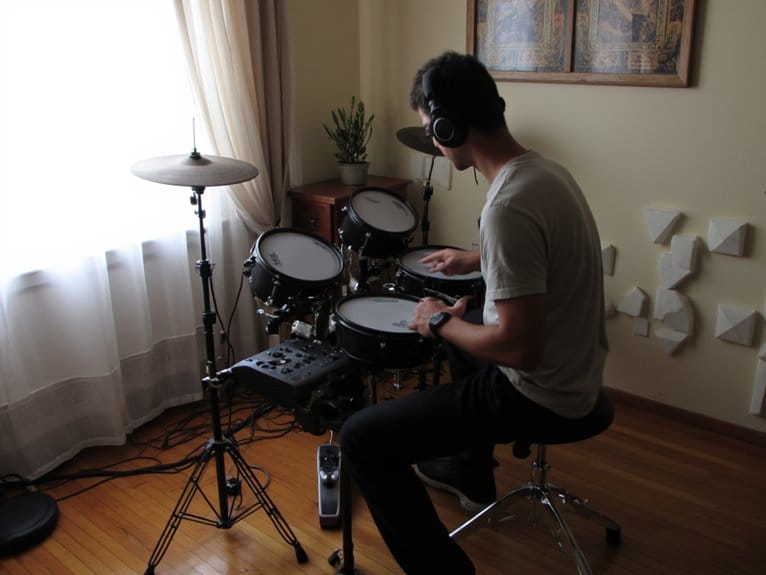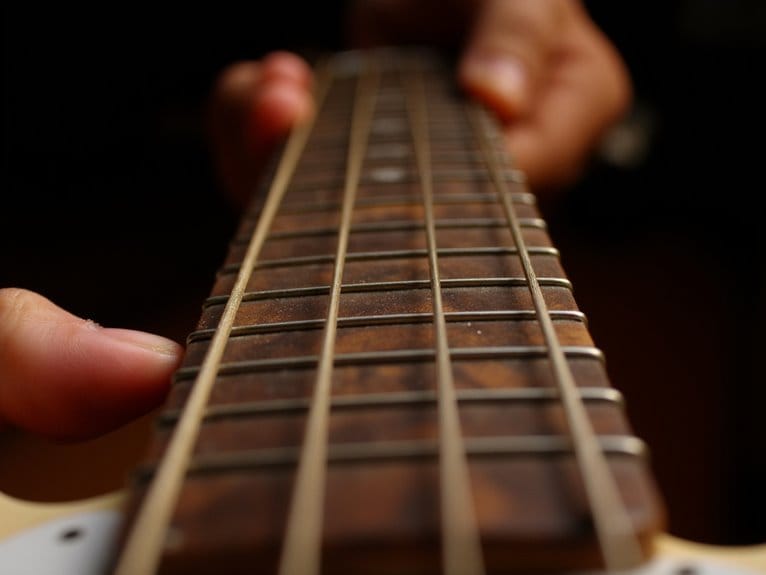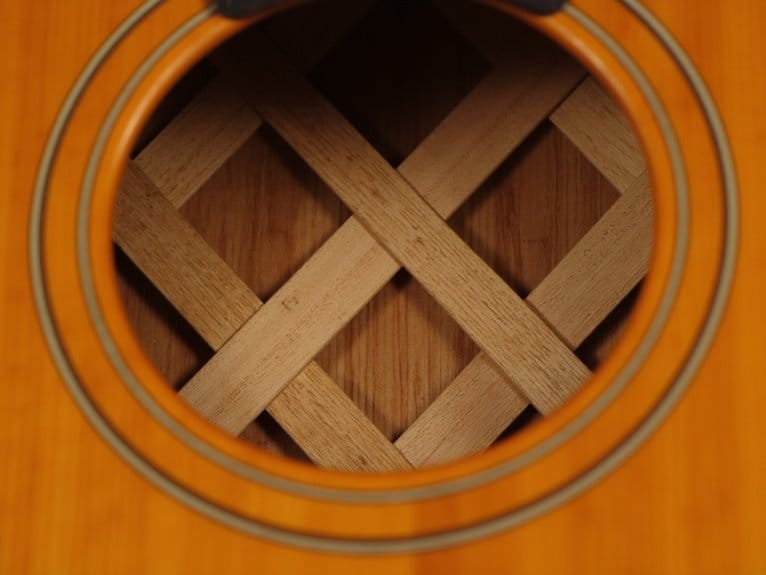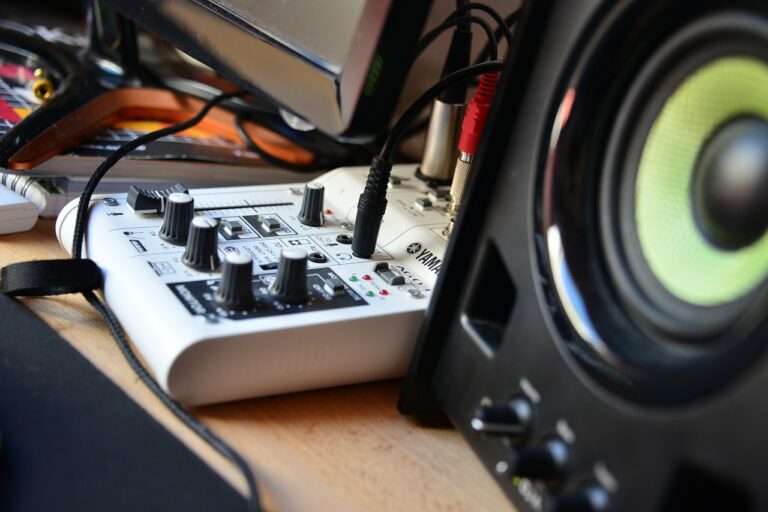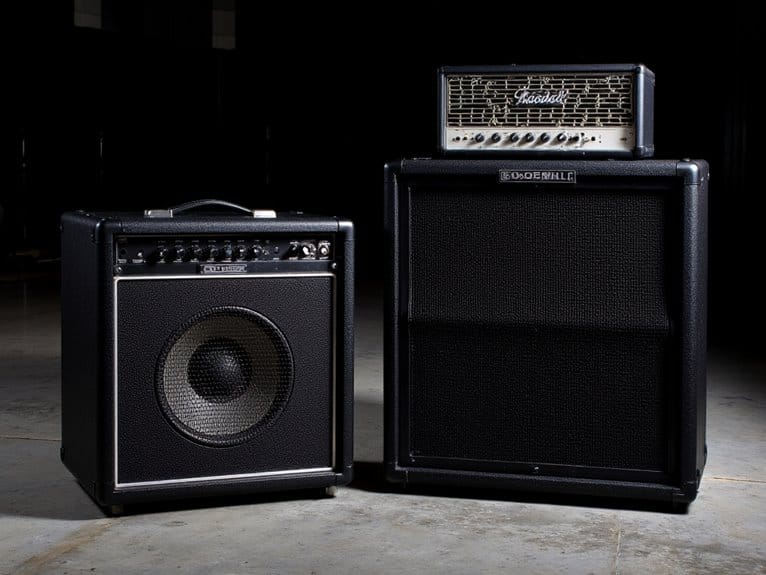Apartment Drumming Solutions: Staying Quiet While Staying Creative
You can absolutely practice drums in your apartment without evicting notices by switching to electronic drum kits with headphones, which eliminate noise completely while maintaining authentic playing feel. Mesh heads on acoustic drums reduce volume by 95%, while bass drum damping and low-volume cymbals further minimize disturbance to neighbors. Tennis ball risers under your kit prevent floor vibrations, and thick blankets provide affordable sound absorption that won’t damage rental walls. The complete setup strategies below will maximize your creative potential.
We are supported by our audience. When you purchase through links on our site, we may earn an affiliate commission, at no extra cost for you. Learn more.
Notable Insights
- Electronic drum kits with headphones provide silent practice while maintaining creative flexibility through customizable sounds and MIDI connectivity.
- Mesh drum heads reduce acoustic drum volume by 95% while preserving realistic stick response and playability.
- Soundproofing techniques like acoustic panels, resilient clips, and vibration isolation prevent sound transmission to neighboring apartments.
- Temporary solutions including thick blankets, tennis ball risers, and positioning away from shared walls minimize neighbor disturbances.
- Scheduled practice times during neighbors’ absence combined with quiet accessories maintains positive relationships while enabling creative expression.
Electronic Drum Kits: Your Apartment-Friendly Solution
When I first moved into my cramped studio apartment with paper-thin walls, I thought my drumming days were over—until I discovered electronic drum kits, which have become the go-to solution for apartment dwellers who refuse to give up their passion for percussion.
These kits use rubber or mesh pads instead of traditional drum heads, producing soft mechanical thuds rather than ear-splitting crashes. You can achieve completely silent performances using headphones, allowing late-night practice sessions without angry neighbor complaints.
The compact design fits perfectly in multipurpose rooms, and most kits fold down for storage when you’re not playing. With digital sound modules offering customizable drum sounds, metronomes, and play-along tracks, you’ll actually gain creative flexibility while solving your noise problems. You can change drum sounds instantly at the touch of a button, switching from acoustic to rock to hip-hop kits without owning multiple physical drum sets. Many models feature dual-zone mesh pads that enhance dynamic response and provide more realistic playing sensations than basic rubber alternatives. Many modern electronic drum kits include MIDI connectivity that allows seamless integration with recording software and digital audio workstations for enhanced creative possibilities. First-floor apartments experience fewer issues due to no neighbors below, making them ideal locations for electronic drum setups. Understanding power output requirements helps ensure your electronic kit delivers sufficient volume and dynamic range for your specific practice needs.
Modifying Acoustic Drums for Quieter Practice
If you’re committed to your acoustic kit but need to keep the peace with neighbors, you can transform your drums into practice-friendly instruments through strategic modifications that preserve much of the natural playing feel.
Mesh drumheads offer the most dramatic volume reduction, cutting acoustic output exponentially while maintaining realistic stick response and rebound characteristics that rubber pads simply can’t match. Many electronic drum sets use mesh pads that operate at noise levels below 37dB, demonstrating just how effective this technology can be for quiet practice. For additional sound control during practice sessions, consider incorporating built-in overdrive circuits found in modern amplification systems that allow seamless switching between clean and processed tones.
Your bass drum presents the biggest challenge since low-frequency vibrations travel through walls easily, but internal dampening with blankets or pillows, combined with softer beaters, can greatly reduce those neighbor-disturbing thumps. For cymbals, consider low-volume cymbals from brands like Zildjian and Sabian that provide the authentic metal hitting experience without the excessive noise that traditional cymbals produce. The B20 construction found in quality cymbals provides rich harmonics that even low-volume versions can preserve to some degree.
Mesh Heads and Sticks
One of the most effective modifications you can make to your acoustic drum kit involves replacing standard drumheads with mesh alternatives, which dramatically reduce volume while preserving much of the tactile experience that makes drumming enjoyable.
These mesh heads cut noise by approximately 95% compared to acoustic heads, though you’ll notice they feel slightly synthetic initially. Premium options like Evans dB One series offer more realistic rebound characteristics, helping bridge that gap between practice and performance feel.
Mesh head maintenance proves minimal since the durable fabric construction resists wear better than traditional heads.
Your stick selection becomes important too—lighter sticks complement mesh heads’ reduced rebound, while heavier sticks can help simulate acoustic playing dynamics during quiet practice sessions.
Bass Drum Dampening
The bass drum presents apartment drummers with their biggest acoustic challenge, since its low-frequency energy travels through floors, walls, and ceilings with remarkable efficiency, making your downstairs neighbors acutely aware of every kick pedal strike.
Internal muffling offers your most effective solution, with household pillows or specialized products like Evans EQ pillows placed inside the shell to absorb resonance without completely killing the drum’s response. For non-ported drums, you’ll need to remove the resonant head to access the interior cavity properly.
External dampening methods, including muffling rings like the Evans EMAD or adhesive felt strips on the drumhead surface, provide additional control over sustain and attack. When recording your quieter practice sessions, dynamic microphones excel in these dampened environments due to their ability to handle the reduced sound pressure levels effectively.
Combining isolation platforms beneath your bass drum with these muffling techniques addresses both airborne sound and structural vibration transfer. For complete volume reduction during practice sessions, low volume cymbals designed specifically for noise-sensitive environments can eliminate the harsh overtones that typically accompany acoustic drum setups.
If you’re recording your dampened bass drum, consider how your chosen signal-to-noise ratio will affect the clarity of the quieter, muffled sound when selecting microphones for the setup.
Soundproofing Your Practice Space on a Budget
When apartment living meets your drumming passion, you’ll quickly discover that creating an effective practice space doesn’t require breaking the bank or your lease agreement. Start with resilient clips and hat channel systems, which decouple your walls from structural vibrations without permanent modifications. Add two layers of drywall with Green Glue between them for mass-loaded dampening, then seal every gap with acoustic caulking to prevent sound leaks.
| Budget Solution | Cost Range |
|---|---|
| Acoustic panels + bass traps | $200-400 |
| ClearSonic drum shields | $300-600 |
| MLV window plugs + door seals | $100-250 |
These sound barriers, combined with strategic mineral wool placement in cavities, create surprisingly effective isolation while preserving your security deposit and maintaining neighborly relationships.
Floor Protection and Impact Noise Reduction
While wall treatments handle airborne sound beautifully, I’ve learned the hard way that your downstairs neighbors won’t appreciate the thunderous kick drum impacts traveling directly through your floor structure, no matter how many acoustic panels you’ve hung.
Floor isolation becomes critical when you’re dealing with percussive instruments that create mechanical vibrations.
Percussive instruments generate mechanical vibrations that travel directly through floor structures, making proper isolation absolutely essential for any serious home studio setup.
I’ve found that layering Auralex Platfoam with Sorbothane dampers under drum platforms provides excellent impact absorption, though carpet and foam mats alone won’t cut it for electronic kick drums.
Mass loaded vinyl adds necessary weight to block vibration transmission, while rubber pads between drum feet and flooring absorb those sharp impacts.
Building a decoupled riser platform with multiple isolation layers, incorporating dense materials like MLV with shock-absorbing foams, creates the most effective barrier against structural vibration transfer.
Consider investing in quality hardware with anti-slip feet that work in conjunction with your floor protection system to minimize vibration transfer while maintaining drum stability during practice sessions.
Temporary Solutions for Renters
Since you can’t mount permanent acoustic treatments or build custom isolation platforms in most rental situations, I’ve discovered that electronic drum kits with headphones represent the single most effective solution for apartment drummers who need to respect lease agreements.
You’ll eliminate most neighbor complaints while maintaining your practice routine, though I’d still recommend positioning your kit away from shared walls for maximum consideration.
For sound absorption, hanging thick blankets or DIY panels provides affordable noise reduction without wall damage, while tennis ball risers under your kit offer excellent vibration isolation from floor transmission.
Lightweight room dividers create additional barriers using pressure-mounted hardware that won’t violate rental terms.
Combining these temporary solutions with scheduled practice times during neighbors’ absence creates an all-encompassing approach that maintains both your musical passion and positive relationships.
Creating a Complete Quiet Drumming Setup
Building upon those temporary measures, I’ve found that assembling a truly thorough quiet drumming setup requires strategic component selection, precise positioning techniques, and smart integration of both acoustic dampening and electronic alternatives.
You’ll want to start with an ultra-quiet electronic kit that reduces noise by 75%, then add specialized drumming accessories like noise-canceling rings and rubber mutes for any remaining acoustic components.
Proper assembly guarantees stability while preventing rattles, and I can’t stress enough how much difference correct drum positioning makes for control.
Bluetooth connectivity enables silent practice through headphones, while MIDI recording capabilities let you track progress without disturbing neighbors—creating the complete apartment-friendly solution.
Models with mesh heads provide enhanced playability while significantly reducing noise compared to traditional drum surfaces, making them ideal for apartment practice sessions.
For the ultimate in space-saving convenience, consider roll-up electric drum pads that weigh just 1.7 pounds and provide 8-10 hours of battery life for extended practice sessions.
Many drummers overlook the importance of headphone outputs for truly silent practice, which allow you to play along with backing tracks while maintaining complete sound isolation from your neighbors.
Frequently Asked Questions
What Are the Noise Ordinance Laws for Drumming in Apartments?
Noise regulations for apartment drumming vary by municipality, but you’ll typically face quiet hours from 9-11 p.m. until morning. Sound disturbances can result in warnings, fines, or equipment confiscation if you’re repeatedly violating local ordinances.
How Do I Talk to Neighbors About My Drumming Practice Schedule?
You’ll want to approach neighborly communication with transparency about your practice times and demonstrate scheduling flexibility. Be proactive, offer specific hours, show your noise-reduction efforts, and ask for their input on timing preferences.
On a final note
You’ve got the tools to keep drumming without evicting yourself or driving neighbors crazy. Whether you’re rocking electronic kits, dampening acoustic drums, or building makeshift soundproofing with moving blankets, there’s a solution that fits your budget and living situation. Don’t let apartment life kill your rhythm—with these strategies, you’ll maintain your chops while keeping the peace. Your creativity doesn’t have to suffer for quieter practice sessions.

